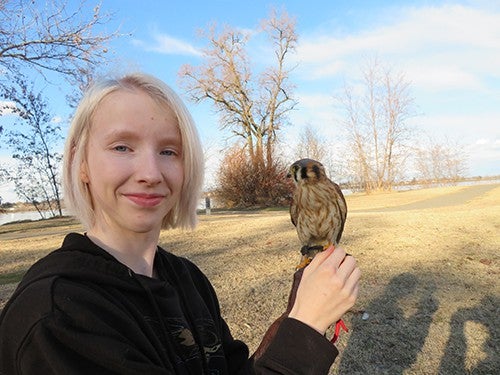Birds of prey aren’t easy to train, and Sierra Wagner has the scars to prove it. The 18-year-old apprentice falconer captured a wild American kestrel several weeks ago and is working to gain its trust.
“It was an angry, trapped bird and it let me know; I have a ton of scratches,” she says. “You need so much patience to work with birds of prey.”
Wagner became obsessed with the ancient sport of falconry in sixth grade when she read a novel about a character who kept a peregrine falcon. She started tagging along on guided hunts with a falconer near her hometown of Kennewick, Wash., when she was just 14.
It was the first step in a long process toward becoming an apprentice falconer that included classes in raptor education and caring for falcons, which she took through the Northwest School of Falconry. In January, Wagner passed the test to earn a license that is required for falconers to own birds of prey such as red-tailed hawks and kestrels.
Wagner works closely with a mentor, a falconer who has birds ranging from peregrine falcons to Harris hawks. The pair worked together to capture the kestrel, and Wagner has started training under the close supervision of her mentor.
The process of training a falcon takes time. Within a few months, Wagner hopes her winged partner will learn to hop up and eat out of her gloved hand and, before long, the pair will go out on hunts together. The kestrel, at the end of a special leash, will capture small animals such as lizards, mice and smaller birds and bring them back to Wagner who will save them for feeding time.
Although the ultimate goal is mutual trust, Wagner knows her relationship with the kestrel will be short-lived, explaining, “It’s not a pet that I’ll keep forever; apprentice falconers capture their first birds from the wild, train them and, after a year or so, release them back to the wild.”
Wagner participated in FFA at Kamiakin High School, serving as chapter secretary and vice president before graduating in 2018. Although she had no involvement with birds of prey through her chapter, Wagner believes there are parallels between what she learned in FFA and her work with the kestrel.
“Birds of prey are used for [pest] abatement in agriculture. They chase off pests like starlings from blueberry fields and orchards. I have a job doing abatement with birds of prey this summer,” she explains. “It’s showing me that there are different ways to use the things you’re passionate about to get a career in agriculture.”












